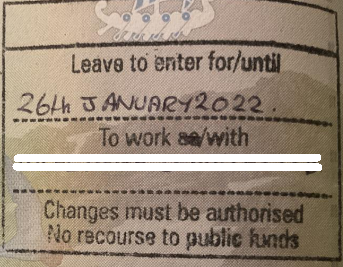- BY Ross Kennedy

How to use the creative worker visa concession
THANKS FOR READING
Older content is locked

A great deal of time and effort goes into producing the information on Free Movement, become a member of Free Movement to get unlimited access to all articles, and much, much more
TAKE FREE MOVEMENT FURTHER
By becoming a member of Free Movement, you not only support the hard-work that goes into maintaining the website, but get access to premium features;
- Single login for personal use
- FREE downloads of Free Movement ebooks
- Access to all Free Movement blog content
- Access to all our online training materials
- Access to our busy forums
- Downloadable CPD certificates
The UK immigration system as it applies to the creative sector is a complicated hodgepodge of different categories, each with their own requirements and restrictions, advantages and disadvantages. These include visitor-based routes, such as creative visitors, permit free festivals and permitted paid engagements, as well as the now ubiquitous sponsored work visa that has taken over immigration in the last couple of decades.
Workers in the creative sector can be sponsored under the skilled worker route if they are working in longer-term roles for a single employer which will meet the minimum skill and salary requirements. However, this often doesn’t reflect how the creative sector works in the real world. People are often freelance and don’t work solely for a single employer, moving from one gig or project to another within short periods.
In order to cater for this sector, sponsorship under the creative worker route can come from a wider range of organisations than just an employer, with broadcasters, productions companies and even agents or performance venues able to get a licence to sponsor creative workers.
As well as flexibility over the sponsor, the creative worker route can in certain circumstances also benefit from a concession for some nationalities that means they only need sponsorship and they do not then need to apply for the visa in order to travel to the UK. They still need to meet all the requirements (including sponsorship) and are subject to the same conditions (including working restrictions), but the concession makes the process easier and cheaper for people the Home Office considers to be “low risk”.
How the concession works
The concession is only available for non-visa nationals – those nationalities who would not need to apply for a visa to come to the UK as a standard visitor. The nationalities that need visas to come to the UK as a standard visitor are listed in paragraph VN 1.1 of Appendix Visitor: Visa national list. This means that any nationality that is not listed here may be able to benefit from the concession.
In addition to being a non-visa national, the total duration that the person is being sponsored for must be less than three months. This includes where the person has a single engagement or where they have consecutive engagements for which the total length of the engagements (including time between engagements) is three months or less.
The worker still needs to be sponsored under the creative worker route, so they still need to have a sponsor and to be assigned a certificate of sponsorship. However, if they are a non-visa national and being sponsored for under three months, they do not need to apply for a visa before travelling – they can just present their certificate of sponsorship to a border force officer on arrival.
If a non-visa national is being sponsored for longer than three months, or if a visa national is being sponsored for any duration, they will need to apply for a visa before travelling to the UK.
Arriving in the UK
As we have explained previously, a person using the creative worker concession to travel to the UK with just a certificate of sponsorship and without a visa must see a border force officer on arrival. They must not use the ePassport gates to enter the UK.
For some time now, citizens of Australia, Canada, Japan, New Zealand, Singapore, South Korea, USA, EEA states and Switzerland have been able to use ePassport gates to enter the UK instead of seeing a border force officer.
However, the eGates are only able to grant permission to enter as a visitor or on the basis of an existing visa. People travelling to the UK under the creative worker concession do not have a visa so the eGates would only grant them permission as a visitor. As visitors are not permitted to work in the UK, carrying out the work for which they were sponsored would be a breach of their immigration conditions and illegal employment.
Creative workers relying on the concession need to make sure to see a border force officer and present their certificate of sponsorship. They should then be granted permission as a creative worker for up to a maximum of three months and should be given an ink stamp in their passport.

The creative worker should make sure that their passport is stamped, as otherwise they may have been landed incorrectly as a visitor and would not be permitted to work. Their sponsor will also need to see the stamp in order to verify that they have been landed correctly.
If a person is landed as a visitor they will need to leave the UK and re-enter in order to be granted the correct permission as a creative worker.
If a creative worker needs to leave the UK during the period of their sponsorship, their permission to enter will lapse each time they leave and they will need to see a border force officer to be granted new entry each time they arrive. However, they can continue to rely on the same certificate of sponsorship as long as it is still valid.
Travelling to the UK via Ireland
As Ireland forms a common travel area with the UK, there are not normally any immigration controls between the two. If a creative worker using the concession intends to travel to the UK via a connecting flight through Ireland, they will not be able to see a border force officer in order to be granted the correct permission as above.
In this situation, the creative worker needs to ask for permission to enter in advance – this is called the ‘remote clearance process’. They still don’t need to get a visa if they are sponsored for under three months and are a non-visa national, but they need to get advance approval to enter the UK via Ireland.
Creative workers (or their sponsors) need to complete an immigration clearance form at least 72 hours before they arrive in the UK. If successful, the form will be endorsed and returned to the worker electronically, in place of a passport stamp. Permission must be granted before the worker arrives in the UK or they will instead be deemed to be a visitor and would not be permitted to work in the UK.
This process can only be used by creative workers using the concession who are travelling from a place outside the common travel area (the UK, Ireland, Channel Islands and Isle of Man) via Ireland to the UK. It cannot be used if they arrived in Ireland from elsewhere within the common travel area.
Electronic travel authorisation
The UK is in the process of rolling out a new system that will require non-visa nationals who don’t require visas to travel to the UK to apply for travel authorisation in advance. This new system is called electronic travel authorisation and operates in a similar way to the ESTA in the US, the ETA in Canada and the upcoming ETIAS process soon to be introduced by the European Union.
Electronic travel authorisation will apply to anyone who is able to travel to the UK without a visa. This means it will mostly apply to visitors, but as creative workers using the concession are also travelling without a visa, the electronic travel authorisation requirement will also apply to them.
At the moment, electronic travel authorisation is only required by citizens of Qatar, Bahrain, Kuwait, Oman, United Arab Emirates or Saudi Arabia. This requirement is going to be extended to non-European citizens who are non-visa nationals who arrive in the UK from 8 January 2025 (applications will open from 27 November 2024) and to European non-visa nationals who arrive in the UK from 2 April 2025 (applications open 5 March 2025).
Applications cost £10 and allow visa-free travel to the UK for purposes covered by visitor rules, transiting the UK or under the creative worker concession. The electronic travel authorisation lasts for two years, or until the expiry of the passport used to apply for it.
Other sponsorship considerations
There are a host of other factors that sponsors will need to consider when assigning a certificate of sponsorship, including factors such as the rate of pay and whether the creative worker will be displacing a resident worker.
For many types of roles in the creative industry, there is a code of practice which sets out when a person will be considered to be making an additional contribution to the UK and not displacing a resident worker, as well as what recruitment efforts are required if these requirements are not met. The codes of practice also address the applicable rates of pay for those types of work.
Where a code of practice doesn’t apply to the specific type of work, the rules used to require that sponsors take into account the needs of the local labour market and advertise where appropriate. Since April 2024, the sponsor needs to ensure that the worker will be able to demonstrate that they can make a unique contribution to creative life in the UK. This is a somewhat subjective test, but guidance suggests that sponsors look to the codes of practice for examples, such as where the worker has international status in their field or certain skills or attributes that are unlikely to be available in the resident work force.
Recent changes
The government announced in September that they were making further tweaks to the new rules introduced in April. From 8 October 2024, instead of sponsors ensuring that the worker will be able to demonstrate that they can make a unique contribution, sponsors will need to demonstrate this.
This change of emphasis appears to suggest that a greater burden may be placed on the sponsor so that, instead of just retaining evidence in case the Home Office or border force ask for it, they may be required to present this in advance. This could mean that it may need to be provided as part of a visa application or, in the case of a creative worker using the concession, when seeing a border force officer on arrival in the UK.
However, this would seem to be a significant change of position which undermines some of the reasons for the concession existing in the first place. Sponsors are already asked to complete a question when assigning the certificate of sponsorship about how they have complied with the relevant code of practice or how the migrant will be making a unique contribution (previously this was how the sponsor considered the resident labour market).
It may be the case that they will just need to provide more details here than they may have done previously. The updated sponsor guidance from the Home Office for this route still says that sponsors “must be able to show” rather than “must demonstrate” (as appears in the updated rules) and that details must be included in the text box provided or in an additional sponsor note, if necessary, with relevant evidence retained by the sponsor as previously.
SHARE

